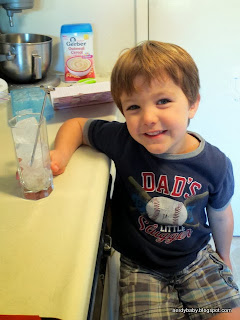I thought I'd share our experience with melting ice and colors and how we conducted the experiment. J had a great time, and he really directed the lesson. I was happy with how it turned out!
We tried to fill the ice cube trays with primary colors (red, blue, yellow) food coloring and then added the water, and it was a disaster. I rinsed out and started over. We filled our ice cube tray 1/2 full of water (to give us a little wiggle room putting into the freezer) and then added the primary food coloring drops (4 drops per cube). We stirred each color with its own spoon (so we didn't cross contaminate colors before we even started our experiment).
We froze the ice and then placed them into clear custard bowls. We put two ice cubes in each dish, making sure each of the colors mixed (yellow/blue, red/blue, red/yellow). J predicted/hypothesized what was going to happen in terms of colors using little note cards in front of each dish, using markers for his predictions of colors.
I particularly like the yellow, which didn't show up in the wide shot above (see close-up below). I also liked the purple heart and the orange pumpkin.
Now, let me warn you that cheap food coloring is hard to wash off of hands. Both J and I were dyed for a day or two (surprisingly, the clothes remained unscathed):
We let the ice sit through naptime and brought out the paint brushes to see if his hypotheses were correct. He was spot on with his predictions:
Now, J was thinking like a true scientist, "What if..." He wanted to know what would happen if he mixed all of the colors. He tried dipping his brush into all the colors and then painting, but that would just end up the color of the last color he dipped in. Grandma suggested doing dots of each color and spreading them around:
It made brown! However, J wasn't super satisfied or convinced. He wanted to combine all the colors into one big bowl.
He painted with it, and he ended up at the same solution: brown (see brown line above the red line, below)
I loved making this experiment our own, how simple it was, and how excited J got about experimentation.
















